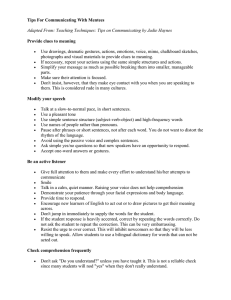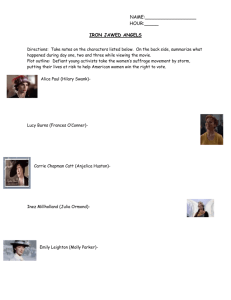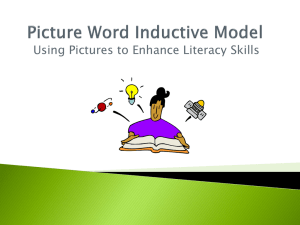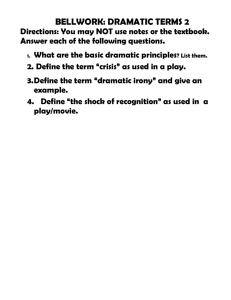JCPS WORKSHOP 4
advertisement
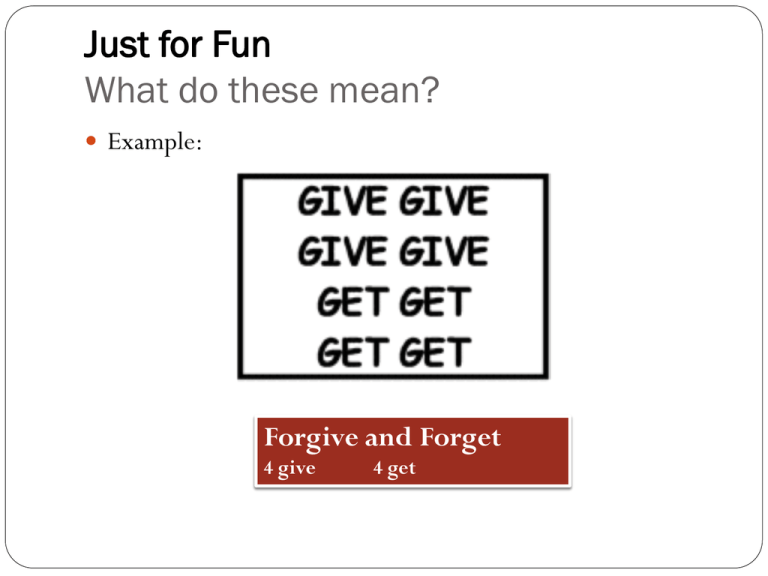
Just for Fun What do these mean? Example: Forgive and Forget 4 give 4 get LOOK U LEAP Look before you leap EARTH R E E H C Peace on Earth Cheer up ppppppp Activity You’ve each been given a word. Someone else has a word that is somehow related or connected to yours. Find that person. Together figure out what the connection is between your words. HINT: Look for someone with the same color paper as yours FIND YOUR PARTNER The Answers prefix Suffix picture image target goal soothing calming buoyant Doesn’t sink Word consciousness Awareness and interest in words comprehension Understanding Student friendly definition Traditional definition WORD LINKS You have just experienced “Word Links”—an activity that can be used to review vocabulary words. In your case, the words you have you will encounter later in this seminar. 2,800 bonus points if you can find those words during this seminar and point them out! WORDS! “Vocabulary Strategies for KS2” November 16, 2013 Claudia L. Keh BA Education (K-8) MA TESOL (UCLA) Adult Education Teaching Certificate Doctoral Candidate HKU Goals for the Seminar THEORY Hong Kong Context Key Stage 2 PRACTICE Today’s Menu: PART 1 Selecting words to teach Guiding questions Word-learning Strategies Prefixes, Suffixes, Roots Teaching Strategy Examples Meaningful Contexts “Definition +” “Four Square” “PWIM” Repetition and Review Word links Thinking skills: Verbal classification Word Consciousness & Word Play Applications for the HK Classroom P6: Movie Reviews P5: News Reports KEY STAGE 2: Vocabulary and Reading Vocabulary KS2 Teachers need to make plans for vocabulary learning and teaching at different stages of learning so that new vocabulary items are introduced in meaningful context and learnt vocabulary items are revisited and practiced in new contexts. Teachers should not overburden learners in primary schools with too many new vocabulary items in each lesson, although they need to set reasonably high expectations of them. Teachers need to predict the vocabulary the learners will need for meaningful completion of tasks and then decide how the vocabulary items are to be introduced through interesting contexts. English Language Education Key Learning Area: English Language Curriculum Guide (Primary 1-6), 2004, p. 165 SELECTING WORDS TO TEACH “Teachers need to make plans…” “Not overburden” “Teachers need to predict…” 3 Guiding Questions Important Is understanding the word important to understanding to understanding the selection in which it appears? a specific concept students Does the word represent concept? definitely need to know? beyond this classroom? How useful is this word outside the reading selection currently being taught? Particularly relevant in EMI contexts. Critical Useful The more frequently a word appears in materials students read, the more important it is for them to know the word. Additionally, the more frequent a word is, the greater chances that students will retain that word. Graves, 2009, p. 26 Choose vocabulary words as if you were paying for each word and you needed to keep them forever GUIDING PRINCIPLE Is this word one most of my students don’t have a rich meaning for? Is this a word my students need to know and could use in speaking and writing? Is this word essential to understanding a selection my students will be reading? Cunningham, 2009, p.72 Text-Types Rare words per 1,000 I Printed texts Abstracts of scientific articles Newspapers Popular magazines Adult books Children’s books Preschool books 128.0 68.3 65.7 52.7 30.9 16.3 II Television texts Prime-time adult shows Prime-time children’s shows Mister Rogers and Sesame Street 22.7 20.2 2.0 III Adult speech Expert witness testimony College graduates’ talk to friends 28.4 17.3 Adapted from Hayes & Ahrens, 1988 cited in Graves et al. 2013, p.39 AUTHENTIC TEXTS Frequency of RareWords inVarious Sources Vocabulary (reading) KS2 Teachers also need to include the teaching of vocabulary building skills in the plans for a school-based English Language curriculum. It is not enough to stop at anticipating and addressing the needs of their learners for specific vocabulary items to respond to questions, express views and feelings and carry out given tasks. Over time, teachers need to model different attack and organize words. Use known ways in which learners can parts of words or word association to work out the meaning of unknown words (e.g. happy/unhappy; bath/bathroom) English Language Education Key Learning Area: English Language Curriculum Guide (Primary 1-6), 2004, p. 165 Word Learning Strategies “Model different ways” “attack and organize words” “vocabulary building skills” “Students awareness of prefixes, roots and suffixes (word parts) contributes to their vocabulary growth (Anglin, 1993) and to their reading comprehension (Carlisle, 1995, 2000).” [in Stahl and Nagy, 2006, p.141] The Big FOUR Some scholars declare that four prefixes account for about half the prefixed words in English. What do you think they are? Prefixes: UNAccording to The American HeritageWord Frequency Book, unaccounts for 26 percent of the total prefixed words occurring in school text grades 3-9 (P2/F1) Combined with the other 3 = 51% of the total. CAUTION: NOT FOOLPROOF indelicate does not mean not flimsy under does not mean below the ‘der’ TEACHING STRATEGY Introduce the concept of prefixes: they change the meaning of the “root” word. [prefixes do not appear on their own] “Root” words are small words that are inside larger words and have their own meaning. Activity Equal pieces Unequal pieces This is a picture of two pies. The first pie has equal pieces; the pieces are the same size. The second pie has unequal pieces; the pieces are not the same size. Circle the answer that best completes the sentence. 1. When a knight is afraid, he is scared. If a knight is unafraid, that means a. The knight is scared. b. The knight is not scared. Read the sentence. Then use your knowledge of the prefix un, to tell the meaning of the word in bold. 2. The girl made an unwise choice. If wise means, “smart”, unwise means _________ 3. What does –un mean? Graves et al., 2013 p.80 Re- reappear disappear appear In school you have to write passages in English . Sometimes you have to write the passage another time to make it better. If you have to rewrite your passage it means_______ Mis- misunderstand understand 1. When a child behaves, we say s/he is being good. If a child misbehaves, that means a. The child is being naughty b. The child is acting properly. 2. The boy misspelled all the words on the exam. What mark did the boy get on his test? Over- Baked cooked Overbaked overcooked 1. When a library book is due, you must return it. If the book is overdue, that means a. You returned it on time. b. You returned it too late. Over- Student Prefix Log Prefix Prefix Word Meaning in English Un- unhappy Not happy DisReMisOver- Graves et al., 2013, p. 83 Meaning in Chinese Sentence in English The boy was unhappy because he lost his lunch. Sentence in Chinese Picture Ideas from other teachers Word Learning Strategies: What we’ve done so far… Examples inductive, meaning-based activities focusing on prefixes/suffixes. Examples of activities for student output. Some research suggests that it takes 12 instructional encounters to thoroughly learn a word (Beck, et al, 1982; McKeown et al., 1985) Vocabulary KS2 Teachers need to make plans for vocabulary learning and teaching at different stages of learning so that new vocabulary items are introduced in meaningful context and learnt vocabulary items are revisited and practiced in new contexts. Teachers need to predict the vocabulary the learners will need for meaningful completion of tasks and then decide how the vocabulary items are to be introduced through interesting contexts. English Language Education Key Learning Area: English Language Curriculum Guide (Primary 1-6), 2004, p. 165 Rich, Varied, Recycled Experiences “ Meaningful completion of tasks” “Interesting/ meaningful/ new contexts” Introductory Instruction “Virtually all effective vocabulary instruction is likely to include a definition. And not any definition will do.” (Graves et al. 2013, p. 57) Student friendly: Longer, written in complete sentences, do not contain words more difficult than that being defined. [Examples to follow] Traditional and Student-Friendly Definitions Traditional Definitions Dazzling: Bright enough to deprive someone of sight temporarily. Climate: The prevailing weather conditions of a particular region. Contagious: Transmissible by direct or indirect contact; communicable Student-Friendly Definitions Dazzling: If something is dazzling it is so bright that it is hard to look at. After lots of long, dark winter days, sunshine on a sunny day is dazzling. Climate: Climate is the usual weather of a place. Contagious: A contagious illness is an illness that you can get by touching people of things that have the illness. The flu is a very contagious illness. DEFINITION + + Making use of an image can markedly improve students’ understanding of a word, make the instruction more interesting, and better cement the word in students’ memories. Graves, 2009, p. 73 Definition + Teaching Activity Create a student-friendly definition and rich context for the word. Display the target word and its definition. Have students repeat the word several times. E.g.: “Scaffold” A temporary structure that holds something up while it is being built. Definition + Teaching Activity Include an image of the target word. Select pictures carefully so that they clearly convey the particular meaning. [see next slide] Provide opportunities for students to briefly discuss the words. Pose questions; get students to personalize the word; provide sentence stems for students to complete using the word. E.g.: Where do you see scaffolds? In Hong Kong what are scaffolds made of? Definition, rich context, and a Picture Item A scaffold is a temporary structure that holds something up while it is being built. There was so much scaffolding around the building that it was difficult to tell what the building really looked like. Definition, rich context, and a Picture Item INTERPRET 25 20 15 Chocolate Green Tea Vanilla Red Bean 10 5 0 Chocolate Green Tea Vanilla Ice Cream Flavors Red Bean Definition, rich context, and a Picture Item Look at the picture. This chart helps interpret or explain how many people like each flavor of ice cream. INTERPRET 25 20 To interpret is to explain the meaning of something. 15 Chocolate Green Tea Vanilla Red Bean 10 5 0 Chocolate Green Tea Vanilla Ice Cream Flavors Red Bean Partner Talk: Interpret the chart. Which flavor is most popular and which one is least popular? What is the difference in the number of people who like the most and least popular flavor? A word we are going to learn is enthusiasm. Enthusiasm is being very excited about or interested in something. [Cantonese?] Whole-class response: Let’s all say enthusiasm three times. Let’s look at the picture that helps us understand the word, enthusiasm. The girls are cheering because their team won. Model: I play soccer with enthusiasm. I have an interest in soccer because I like to run and kick the ball. As we read, I want you to listen for the word, enthusiasm. If you hear it, touch your nose. Partner talk: What do you do with enthusiasm? Use the following phrase in your answer: “I….with enthusiasm because…” Longman Express: Reading and Writing 5B Crowded It means __________. Partner talk: Name a place that is very crowded. Describe it and I’ll see if I can guess the place. Is this correct? Causeway Bay is very crowdy on Saturdays. Longman Elect 5B Dear Susan, Thank you for your tips and advice for visiting London. I am very happy that you are visiting Hong Kong. If you like sightseeing…. If you want to buy souvenirs, you should visit Stanley.You can shop at the market there. You can also go to the beach. If you go to Stanley, you shouldn’t go at weekends. It is very crowded. Hope to hear from you soon, Love, Ken FOUR SQUARE TECHNIQUE Four Square Vocabulary Learning Eeds and Cockrum (1985) STEPS: Students fold a piece of paper so it makes four sections. The students write the target word in the upper left section. The teacher gives a definition BUT it is not written down. It is only intended to start a conversation. Ask students for examples of the concept. Record in the upper right quadrant. Ask for non-examples and record. Finally ask students to write their own definition. Four Square soothing Bath Soft music Lying down Something that is soothing relaxes you Traffic Yelling exams Can you write your own definition of soothing? Can you give me an example of something soothing? Can you give me an example of something soothing? NOT ACTIVITY: Your turn buoyant Examples of the concept Boats Balloons Cork Definition of the word Something that is buoyant floats Non-examples Bricks Rocks nails Weights Other Options (Draw a picture) Four Square Writing Brain Reboot Shark Attack! Baby Shark Momma Shark Papa Shark Surfer Dude Saw a shark Shark attack Swam away “Where’s my board?” Surfing Shark PWIM PICTURE WORD INDUCTIVE MODEL Emily Calhoun (1999) PWIM uses pictures containing familiar objects, actions and scenes to draw out words from children’s listening and speaking vocabularies. PWIM helps learners add words to their sight reading vocabulary, as well as their writing vocabulary. Learners can also discover phonetic and structural principles present in those words. Label the picture Label the picture Examples from other teachers PWIM: STEPS Ask students what they see. Label the picture. Read and review. Have students repeat. The words are categorized and read as a class over a series of days. Identify common characteristics: nouns, verbs, adjectives, similar beginning consonants, rhyming words etc. Lead class to give the picture a title. Get students to think about the information and what they want to say about the picture. Ask class to generate sentences using the words. Then, depending on the grade level, the sentences are categorized and formed into paragraphs. Teacher MODELS writing sentences to form a good paragraph. The students then write paragraphs (if applicable). Read and review. What items in the picture might be labeled? How would you guide your students to categorize the words? How might you use the students’ input to promote language usage? PWIM http://mmegc.wordpress.com/tag/pwim/ Verbs were added later and printed in RED The teacher’s next step: “We worked really hard on our phonics and high frequency words. I used the sticky notes to show how changing the initial consonant makes a new word that rhymes. face -race-lace, house -louse-mouse, kid, hid ,lid, did…” NOTE: Your photograph should be a living document-not wall paper. “We worked on building sentences with sentence blocks by rolling the blocks and composing sentences. Sometimes they made sense -sometimes they didn’t . The laughter and selfcorrecting led to better comprehension. Students then wrote their favorite sentences into their notebooks.” “This activity also improves fluency and comprehension. Students then illustrated their sentences. Stronger students worked on paragraph writing by rolling multiple sentences and illustrating the sentences”. [next slide] Noticing Language in Context “We read a lot of books to see how real authors started sentences so that not all of our sentence would start with THE”. Writing Titles “We worked a lot on titles. Titles are a good lead into main idea and determining importance. We studied different titles of published books. I brought in stacks of books and students had to compare and figure out inductively what kind of title the stack represented. We looked at one word titles, question titles, titles that start with the, repeating titles and titles with alliteration. We used the sentences to help us write class and individual paragraphs”. Possible Photos for PWIM Idea from local textbook: “My Pals” Idea from local textbook: Longman, “Elect” What we’ve done so far… Meaningful contexts: Contextualized meaning- pictures Student-friendly definitions Definition Rich words 4-Square Method PWIM Student engagement in learning Input & Output Repetition and Review “No matter how well we initially teach a word, it is much more likely that students will internalize and remember the word if they see it again and better yet work with it actively.” Graves et al., 2013, p. 69 Review Activity Word-links: Review Cognitive Pair work Oral language Adjectives Content words This was your first activity in this seminar. Building Thinking Skills Verbal Classifications Howard and Sandra Black, 1984 Thinking skills: Adapting to Local Primary Schools Unit: Movie Reviews Explain the exception Cartoons, comedy, drama, news report ___________________________________________________ Cartoons are not “real”; they are animated Class and Members Comedy, drama, horror, movie genres genre CLASS __________________ Movie genres MEMBERS, MEMBERS, comedy,________, drama, horror _________, _______ Sorting into Word Classes Word choices Boring, exciting, dull, too long, entertaining, interesting, touching, bad, wonderful Positive Negative Word Consciousness & Word Play Promoting Word Consciousness Word consciousness = awareness of and interest in words. Create a word-rich environment Rhymes, Books Promote Word Play “Hink-Pinks” “Wuzzles” http://www.wuzzlesandpuzzles.com/wuzzles/ Hink-Pinks (with visuals) Brown crown Pink drink Wet pet Stuck truck A crying father Sad Dad A rabbit who tells jokes An overweight kitty Fat Cat Funny Bunny Application: Local Hong Kong P6 P6 Movie Reviews Put these words in alphabetical order Incorrect Interesting Incredible Interrupt Interesting Incorrect Interrupt Incredible Circle the words which could be used to describe a movie Boar Boring Board Bore Bore Bored Bored Boar Boring board Circle the words with similar meaning P6 Movie Reviews How many words can we make? +un unexcited -able excitable -ment excitement -ed excited excite -ing Exciting +un unexciting P6 Movie Review How many words can we make? -ed bored bore -dom boredom -ing boring P6 Movie Review Find the “judgment” words the writer uses to tell his/her opinions about “Iron Man 3”. Underline them. I just I justsaw sawIron IronMan Man3.3.The Thevillain villainwas wasexciting and exciting the heroes and the were heroes all interesting, were all too. I was surprised interesting, (?) bytoo. the ending I was surprised and happy bythat the I went ending to see andthis happy movie. that Even I wentmytomother see thisliked the movie. movie. Even my mother liked the movie. Overall Overallthis thisfilm filmwas____. was____. great! Change these words by adding or deleting a prefix or suffix. P6 Movie Review How did the meaning change? I just saw Iron Man 3. The villain was unexciting and the heroes were all uninteresting, too. I was unsurprised by the ending and unhappy that I went to see this movie. Even my mother disliked the movie. Overall this film was____. bad. P5 News Report Zoo Animal Translator Device An engineer has invented a device that can understand zoo animals’ language. The “Zoonslater” (zoo+ translator) is now being tested at a zoo in Singapore. “The results so far are exciting, but not what we expected,” the zoo keeper said. “The animals seem to like to comment on each other’s appearance.” Activity Activity Wow. You are really tall! I am taller than you, but my mother is very very tall! She is much taller than I am. Yes. It is strange. I have never seen a green elephant. Look at that elephant! He is green! I didn’t know elephants were green!! Are they talking about me? Why do you stand on only one leg? The other leg is tired. I like your hat. I really like your stripes. Thank you. You look a little tired. Have you been staying up late again? Yes. I’ve been playing Video games again. What we’ve done Thinking Skills Word Consciousness & Word Play Application to local situations: Movie Review (P6) News Report (P5) PART II: Reading Skills Working out the meaning Context clues Read Aloud Picture Walks WBT Principles for designing effective Reading Lessons Reading/Vocabulary KS2 Work out the meaning of an unknown word or expression by using and knowledge of the world visual clues, context Understand intention, attitudes, feeling conveyed in a text by recognizing features such as the choice and use of language Teachers should move learners to words needed to express opinions (on general topics) appreciate and interpret a variety of texts express a wide range of ideas for communicative purposes English Language Education Key Learning Area: English Language Curriculum Guide (Primary 1-6), 2004, p. 56-57 Reading (vocabulary) Skills “Known parts” “associations” “Visual clues” “Context” “Understanding intention, attitudes, feelings” “Express opinions” “Use Context Clues” argument We are asking a reader who doesn’t know the word in question to figure out the structural relationships between all the words in the passage. Asking a reader to define a target word by its relationship to other words in a passage assumes this reader knows the meaning of all the “clue” words. p.76 Ohanian (2007). It cannot be assumed that the guessing from context that assists comprehension will necessarily result in the acquisition of new words. If a word can be guessed easily, little attention to its form is needed with the result that the word may not be retained. Graves et al, 2013, p. 26 Example: Instructions: Write a definition for the underlined word in each sentence. Circle the context clues that helped you. Because of its beauty, the magnificent painting was hung in a place of great honor. Asking a novice reader to unpack the meaning of magnificent from the sentence presumes a lot. Does the reader know that magnificent is describing a painting? Does the read know that its is referring to painting? What about the words, honor and beauty? p.81 Ohanian (2007). Context Clues: Recommendations Strategy 1: Look for a definition of the word. Often found in non-fiction. A group of fish is called a school. This is not because it is a place of learning. It is n old word from Holland that means a crowd. Fish live in crowds. -From The cod’s Tale by Mark Kurlansky “ A Muggle,” said Hagrid, “it’s what we call nonmagic folk like them. An’ it’s your bad luck you grew up in a family o’ the biggest Muggles I ever laid eyes on.” -From Harry Potter and the Sorcerer’s Stone by J.K. Rowling Context Clues: Recommendations Strategy 2: Look carefully at the sentence before and after the word in question. Sometimes surrounding words give a pretty good clue to a difficult word’s meaning.You may need to read the whole paragraph very carefully. Sometimes the helpful context comes before the word, and sometimes after the word. “Oh, Mom, can I go on the train and see him, Mom, oooh please…” “You’ve already seen him, Ginny, and the poor boy isn’t something you goggle at in the zoo.” -From Harry Potter and the Sorcerer’s Stone Context Clues: Recommendations Strategy 3: Try to get a feel whether the word is positive or negative. Sometimes the context does not supply a synonym for the word in question but it does help the reader get a sense of whether the word is describing something nice or something not nice. Many animals communicate to warn one another of danger. When every member of a group watches out for predators, they are all more likely to survive. -From Slap, Squeak and Scatter: How Animals Communicate by Steven Jenkins. The rooster charged at her, rapped her viciously—as if beating her for having got herself beaten. - From Along Came a Dog by Meindert DeJong READING ALOUD Students should hear something read well every day. By reading aloud to students, teachers invite them to enter the world of reading. Reading aloud offers students experience with the rhythms of the English language, a model of enjoyment and learning from print, and an opportunity to be engaged with text. Reading aloud is especially beneficial for low achievers (Bridge 1989; Winograd & Bridge, 1995) and works to increase students' comprehension and vocabulary test scores (CochranSmith, 1988). Tips for Reading Aloud Select primarily nonfiction material. Choose passages that capture powerful or useful concepts. Practice reading the selection aloud before you share with students. Plan a few comments to encourage class discussion, such as what drew you to that passage, how you figured out the message, or how you will use the information. Use the passage to emphasize varied concepts in the curriculum. Budget your time—segments of reading aloud can productively range from 5 to 20 minutes when discussion is included. “Picture Walks” [Clay, 1991, 1993; Stahl, 2004] Pictures are used as a catalyst for discussion of what a book is about; or selection of a book. Use the pictures and build vocabulary around the pictures. Nouns are the most obvious, but it is possible to build meaning for verbs and adjectives. Four chosen words: volcano, eruption, lava Does anyone know what we call this? What is happening in this volcano? What is coming out of the top? Have you heard this word before? Has anyone seen a real volcano? Have you seen one on TV or in a movie? Does anyone know what we call this when a volcano has lava coming out of the top like this? Cunningham, 2009, p.79 WHOLE BRAIN TEACHING DIRECTIONS: 100 Arrange your class in groups of twos. If you have an odd number of students, you will pair with the extra student. Without telling your pupils, be sure that a weaker reader is always paired with a stronger reader. Begin: one person on your team reads the first word, then the other person on the team reads the next word, and so on. Keep taking turns. If your partner doesn’t know a word, or mispronounces it, you can say the word for him or her. Keep taking turns, reading as fast as you can. I’ll say ‘stop!’ after a minute. PRACTICE Level 20: she, for, on, they, but, had she, for, on, they, but, had, had, but, they, on on, they, but, had, had, but, they, on, for, she she, for, on, they, but, had, had, but, they, on Mark your team’s record on the page and then I’ll give you another try for a minute. Start over with the first word you read, but whoever started goes second and whoever went second, now goes first. You’ll be trying to beat your previous record. Level 96 in your hand out (2.4.1) Examples of Levels Super Speed 100 Level 44: we, am, then, little, down, do we, am, then, little, down, do, do, down, little, then then, little, down, do, do, down, little, then, am, we we, am, then, little, down, do, do, down, little, then Level 85: over, yours, its, ride, into, just over, yours, its, ride, into, just, just, into, ride, its its, ride, into, just, just, into, ride, its, yours over over, yours, its, ride, into, just, just, into, ride, its Level 100: how, know, part, right, put, sound how, know, part, right, put, sound, sound, put, right, part part, right, put, sound, sound, put, right, part, know, how how, know, part, right, put, sound, sound, put, right, part DIRECTIONS: 1,000 Make a team of two readers. Beginning at line 1 below, you read the first word and your partner reads the second word. Keep taking turns, reading as quickly as possible for a minute. Practice the, to, and, he, a, I, you, it, of, in, was, said, 1 his, that, she, for, on, they, but, had, at, him, 2 with, up, see, all, look, is, her, there, some, 3 word, out, as, be, each, have, go, we, am, 4 then, little, down, do, can, could, when, 5 did, what, so, splootz! 6 Practice 2.4.2 in your handout When your team is finished, mark the last word you or your partner read. This is your team record. Play again for a minute, trying to break this record, but this time, your partner goes first.Your partner reads the first word, you read the second word, and so forth. At the end of a minute if your team beats your team record give a merry cheer. Examples of Levels 1000 better, best, listen, reached, covered, fast, several, hold, himself, toward, true, step, morning passed, vowel, five, ten, hundred, numeral, thousands, knew, north, south, money, map, since, pulled, draw, voice, seen, slow, fast, plan, notice, slowly, sing, war, ever, tall, king, piece, I’ll, unit, figure, certain, across, travel, told, today, upon, bap! 44 45 46 47 48 49 Overview 1. Dramatic Reading 2. Paraphrasing 3. Question and Answer 4. Connecting with other information Structure and Rationale 1. Dramatic reading: The reader reads slowly, so the listener has time to form gestures. The reader gains comprehension by emphasizing key words. The listener adds a kinesthetic dimension to meaning by finding appropriate gestures. (Reading aloud: The teacher reads dramatically and students make gestures dramatizing the text.) Basketball on Wheels Basketball is a hard sport to play. You need strength to move up and down the court. You need to bounce the balls as you go. You must be ready to for a pass. You cannot rest for a second. People who play basketball work as a team. The same is true for people who play basketball from wheelchairs. There are many basketball teams for children in wheelchairs. These children bounce the ball, pass and shoot from their wheelchairs. They learn to move fast in their chairs and keep track of the ball. They must also be good at passing and shooting. They need a lot of strength and balance to play. Just think how high the basket looks when you are sitting down. Wheelchair basketball is a great way for children in wheelchairs to be on a team. These players show us we can all be strong if we try. 2. Paraphrasing: The reader does most of the work, using a dramatic tone and gestures. The listener silently mirrors the gestures. Paraphrasing is a key intellectual skill. Students need hundreds of hours of practice in putting what they read into their own words. (Reading aloud: the reader use gestures and explain what the story was about to the listeners. The listeners mirror the gestures. Demonstrate what you want with one of your brightest students.) Paraphrase/copy I will paraphrase and do gestures. You copy me. 3. Q and A: The Questioner and the Answerer both use gestures and a dramatic tone of voice. Virtually all theories of reading emphasize the importance of asking and answering questions about reading material. (Reading aloud: The readers ask questions with gestures and the listeners give answers with gestures. Demonstrate what you want with one of your brightest students.) Q&A 4. Connecting: Tell your students that any connection they can make between the reading material and anything else they know, or imagine!, is a good connection. According to brain science, we only learn when we link new information to old information. When students get the habit of making connections, you can, where appropriate, ask them to focus on making connections to other course material ... this is more difficult. (Reading aloud: During a group discussion. ask your students questions like, “What does this remind you of?” “Has anyone seen anything like this?”, “Have we studied anything like this?” and so forth ... Connecting Do you play basketball? Is it easy or difficult to make a basket? Have you ever played basketball sitting down? Ones 1. Dramatic Reading Reads slowly with a dramatic tone of voice. Twos Silently uses gestures to show what is being read 2. Paraphrasing Paraphrases what has been read Silently mirrors the with a dramatic tone of voice and gestures. gestures. 3. Q and A 4. Connecting Asks questions about what has Answers questions about been read with a dramatic tone of what has been read with a voice and gestures. dramatic tone of voice and gestures. Using a dramatic tone of voice Silently mirrors the and gestures, makes connections gestures. between reading material and life experiences (and/or course material). More information Principles for Designing Effective Reading Lessons Farrell, T. (2009). Teaching Reading to English Language Learners. Use reading materials that are interesting. Make reading the major activity of the reading lesson. Sustained periods of actual reading. Have a specific objective for each lesson. Language focus: Reading Topic: Sport Objectives: To teach the students to skim and find the main idea of the passage. Prior Knowledge: Students have learned how to locate information by reading and finding the main sentence of each paragraph. Use activities that allow students to bring their own experience to their reading. KWL: What do I Know? What do I Want to know? What have I Learned? Divide lessons into pre-, during- and postreading phases. Activate prior knowledge Skim/scan. Focus on instructional objective—teaching or practicing a strategy. Closure. FYI: READING OUT LOUD Recap THEORY (principles) PRACTICE Principles 1) Provide varied learning experiences: listening, speaking, reading writing 2) Teach individual words: deep, rich, extended; multiple contexts, active processing 3) Teach word learning Strategies: unlock unknown words; context 4) Foster word Consciousness: head and heart: awareness + interest Principles “Vocabulary instruction is most effective when learners are given both definitional and contextual information, actively process new words and meanings, and when they experience multiple encounters with words.” Graves et al, p.4 Goals for the Seminar: Revisited THEORY PRACTICE Principles of effective vocabulary instruction Involve students in active and deep processing of the word. Engage them in activities that lead them to consider the word’s meaning, relate that meaning to information stored in memory, and work with the word in creative ways. Review, rehearse and remind students about the word in various contexts over time, If you teach a word before students read a selection, it is generally a good idea to at least briefly review it after they read. Then throughout the weeks and months following initial instruction, look for and point out other occurrences of the word, ask students to look for and point out other occurrences and occasionally have a brief review of some of the words taught. Provide multiple exposures to the word. Recycle! Graves, 2009, p. 28
